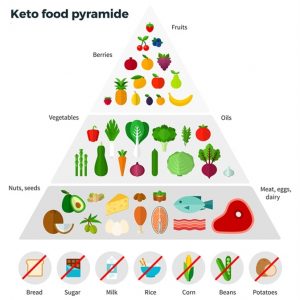Knowing the risks associated with ketoacidosis is important for everyone, from avid health obsessive to the average person. Ketoacidosis, also known as diabetic ketoacidosis (DKA), is an extremely serious health issue, yet it is arguably one of the least understood. This article is designed to give you a solid understanding of the risks and consequences of ketoacidosis, so that you can make well-informed decisions and stay healthy.
Table of Contents
- 1. What is Ketoacidosis?
- 2. Exploring the Potential Risks of Ketoacidosis
- 3. Tips for Prevention & Early Detection
- 4. Managing Ketoacidosis with the Right Treatment
- 5. Living Life with Ketoacidosis: Finding Balance & Empowerment
- Q&A

1. What is Ketoacidosis?
Ketoacidosis, or keto for short, is a metabolic state that can be extremely dangerous and sometimes life-threatening. It occurs when the body is short of glucose, the primary fuel for cellular respiration. Instead, the body begins to break down fat for energy, leading to the production of acidic ketone molecules called ketones. When keto levels rise above the normal range, an individual has ketoacidosis.
Signs and Symptoms of Ketoacidosis
- Excessive thirst
- Frequent urination
- Confusion and irritability
- Extreme hunger
- Stomach pains
Ketoacidosis can be an extremely serious condition and can be caused by a variety of conditions such as type 1 or type 2 diabetes, alcohol-induced intoxication, dieting and fasting, kidney failure, pancreatitis, and certain medications. It can also occur during pregnancy in women who have gestational diabetes. If not treated promptly, it may lead to a coma and even death.
2. Exploring the Potential Risks of Ketoacidosis
Ketoacidosis: The Hidden Risks
When it comes to following a ketogenic diet, one of the most important things to be aware of is ketoacidosis. Ketoacidosis is a potentially dangerous metabolic state in which your body has an abnormally high level of ketone acids in the bloodstream. If left untreated, ketoacidosis can lead to medical and neurological complications, organ failure, or even death. Therefore, it’s important to be mindful of the signs and symptoms of ketoacidosis and take steps to prevent it.
Here are some of the risk factors that may contribute to ketoacidosis:
- Having type 1 diabetes, particularly if sugar levels remain high or insulin dosage is too low
- Having underlying illness, such as pancreatic cancer or heart failure
- Having underlying chronic health conditions, such as kidney disease or liver disease
- Having an acute illness, such as a urinary tract infection or severe dehydration
- Having recently taken certain medications, such as glucocorticoids or diuretics
- Being pregnant
If you have any of these risk factors or are concerned about ketoacidosis, be sure to talk to your doctor before beginning a ketogenic diet.
3. Tips for Prevention & Early Detection
Being proactive about our healthcare is one of the most important things we can do to stay healthy. Here are some helpful tips for prevention and early detection:
- Practice Healthy Habits: Make healthy diet choices, exercise regularly, get plenty of sleep, and keep stress levels in check. These lifestyle habits can help reduce the risk of many types of health conditions.
- Get Screened: Follow through with recommended check-ups and screenings, such as mammograms, Pap smears, and cholesterol tests. This is the best way to detect signs of cancer and other conditions early and establish a baseline on your health.
On top of that, pay attention to any changes in your body, and don’t ignore them. If you experience any unusual symptoms, schedule an appointment with your doctor right away. It is important not to self-diagnose, and it’s always better to be safe than sorry.
4. Managing Ketoacidosis with the Right Treatment
Ketoacidosis can be managed properly with a comprehensive treatment plan. A proper diagnosis and treatment plan tailored to the individual patient’s needs are essential for managing ketoacidosis. In general, ketoacidosis treatment follows a three-pronged approach:
- Insulin Therapy: Insulin is a key component in reversing ketoacidosis and addressing the underlying cause by enabling muscle, body fat, and liver cells to absorb glucose.
- Oral Hydration: Oral hydration eliminates dehydration and prevents the breakdown of muscle and fat by providing the body with much needed fluids.
- Nutritional Intervention: Nutritional intervention is typically provided in the form of a low-carbohydrate, high-protein, ketogenic diet to provide the body with essential nutrients and fuel sources.
In addition to the aforementioned treatments, supportive measures such as blood glucose monitoring, regular doctor visits, and lifestyle modifications may be necessary to maintain tight glycemic control and prevent any further recurrences of ketoacidosis. With the application of insulin, fluid, and nutritional supplementation, ketoacidosis can be managed properly. However, it is important to remember that monitoring and management of ketoacidosis requires an ongoing commitment to preventing further episodes and attaining good health.
5. Living Life with Ketoacidosis: Finding Balance & Empowerment
Diabetes presents a never-ending puzzle for those that live with it: finding balance between blood sugar levels, energy and good health. But what happens when, despite best efforts, your body shifts to a potentially dangerous state called ketoacidosis?
These moments can be uneasy, but with the right education and preparation, living life with ketoacidosis can be an empowering experience. The first thing is to know the signs. During ketoacidosis:
- Persistent and unusual fatigue during the day
- Rapid and increased thirst
- Excessive hunger
- Frequent urination
Being aware of these signals means you can quickly respond to the situation. If you find yourself displaying any of the earlier listed symptoms, seek medical assistance as soon as you can. Always remember that you are in control and you can steer your health in the right direction. Knowledge is power, so learn as much as you can about the condition and create your own plan to work with your medical team to maintain healthy blood sugar levels.
Global awareness of the different types of diabetes and their respective risks is rapidly broadening. Understanding ketoacidosis can help inform of one of the potential risks associated with diabetes, and allow those who are affected by it to remain vigilant and seek out the medical treatment they need. With greater knowledge, all of us can strive for a healthier future.











